|
Adlertag
Messerschmitt Bf 110 C/D/E

Eduard, 1/48 scale
S
u m m a r y |
| Catalogue Number: |
Eduard Kit No. 11145 - Bf 110 C/D/E |
| Scale: |
1/48 |
| Contents and Media: |
Well over 250 parts in grey coloured plastic;12 parts in clear; two photo-etched frets including one in colour; six resin parts for an MK 101 30mm cannon used in Bf 110C-6; self-adhesive masking sheet; markings for
12 aircraft; includes Eduard ground crew and pilot figure set. |
| Price: |
USD$59.95 plus shipping,
available online from Eduard
£34.30 EU Price (£28.58 Export Price) plus shipping available online from Hannants |
| Review Type: |
FirstLook |
| Advantages: |
Limited edition
presentation; one full kit that may be built as Bf 110 C/D (including separate fuselage with long "boat tail"), or E; high level of detail; superb surface
textures including crisply recessed panels and subtle rivet lines where
appropriate; includes colour and brass photo-etched parts; ; narrow sprue attachmentsseparate canopy parts for closed/open cockpit and rear
clamshell; twelve attractive marking options. |
| Disadvantages: |
Modelling experience is required; only later style main wheels supplied. |
| Recommendation: |
Highly Recommended to experienced
modellers or Luftwaffe aficionados |
Reviewed by Brett Green

The Messerschmitt Bf 110 entered the Second World War as a new and
prestigious weapon of the Luftwaffe, performing the roles of
bomber escort, heavy fighter and troop support during the German
invasion of Poland. It performed well against Polish fighters, and put
its heavy armament to effective use against ground targets after the Luftwaffe had established air superiority. The Bf 110 repeated these
roles during the campaign in the West. The long range of the Bf 110 was
especially useful for escorting bombers deep into France.
The twin engine Messerschmitt was more than a match for most
contemporary French fighters, but early encounters with Spitfires and
Hurricanes resulted in unaccustomedly heavy losses. This was an ominous
indicator of the coming months over the British Isles.
In those Summer months of 1940, Messerschmitt Bf 110s on long-range
escort missions suffered heavy losses to British fighters. Eventually,
Messerschmitt Bf 110s had to be escorted themselves by the more nimble
Bf 109s.
Even if its fortunes as a pure fighter aircraft were mixed, the
Messerschmitt Bf 110 had a better record as a defensive weapon.

As early as December 1939, Bf 110 C aircraft of I./ZG 76 were
involved in the decimation of an armed reconnaissance patrol over the
Heligoland Bight. Eight Wellingtons out of a total 22 on patrol were
claimed by the Zerstörers. This single event put massed daylight
bombing off the agenda until 1943, but ZG 2 and ZG 76 continued to enjoy
superiority over Blenheims and Wellingtons in the following months.
The Messerschmitt Bf 110 E, was a refinement of the C and D models with production beginning in August 1940. The Bf 110 E was a useful long distance bomber and heavy fighter. In addition to its ordnance and new gunsight, revisions were also made to the rear machine gun, and inside the cockpit. The most obvious exterior change was the addition of a rectangular air intake on the front of the top gun cowl. The versatile Bf 110 E served on the North African, Mediterranean, North Atlantic and Russian Fronts until 1942 and beyond.
Arguably the most important contribution made to the German war
effort by the Messerschmitt Bf 110 was as a night fighter. The role was
initially ad-hoc. From July, 1940, day fighters were simply painted
black and sent aloft to deal with British bombers, now making their
attacks under the relative protection of darkness. These early night
fighters had no additional equipment nor ground control assistance.
Enemy aircraft were held in the cone of a searchlight, and the Bf 110
would engage the bomber while it was illuminated in the beam.
In this Limited Edition boxing, Eduard has supplied the parts to build one complete Bf 110 C, D or E although only markings for the C and D variants are covered on the kit decal sheet.
The theme of this release is the Blitzkreig, Battle of France, Battle of Britain and into the early Blitz period from September 1939 to October 1940.
The last time I saw an Eduard 1/48 Bf 110 C/D/E kit, it was moulded in khaki coloured plastic. This release is in a medium grey - more pleasant on the eye in my opinion.
Eduard supplies both a standard length C/D/E fuselage and a second optional fuselage with the "boat tail" often seen on the Bf 110 D. The "boat tail" fuselage has the boat deployment cable moulded along the edge of the port-side fuselage spine - a nice touch.
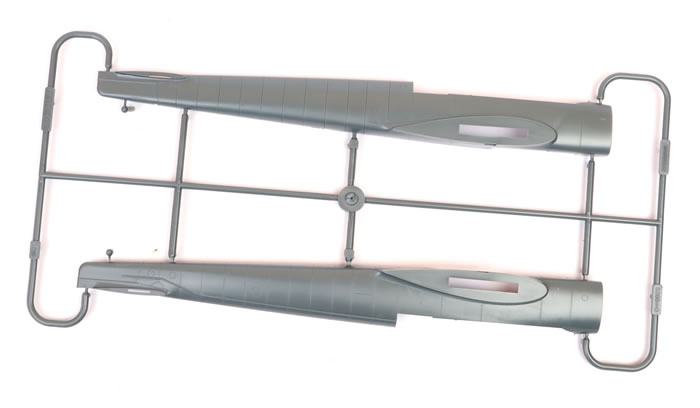
A pre-coloured and a brass photo-etched fret are included.
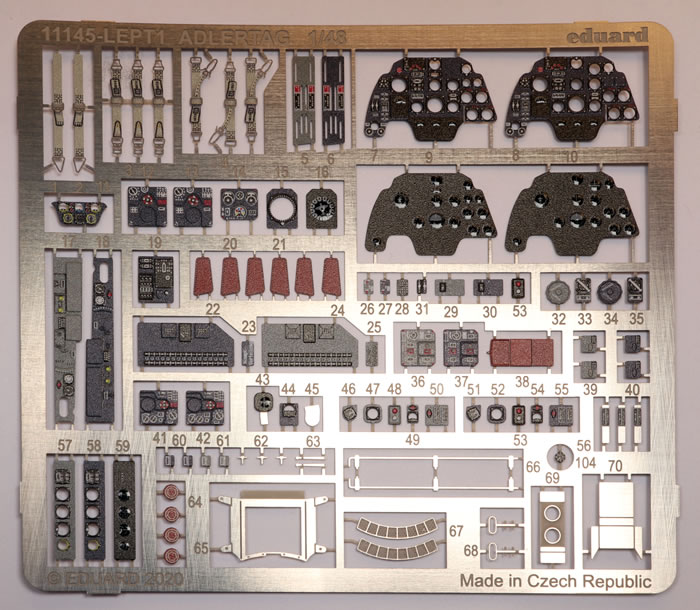
The cockpit interior benefits from colour photo-etched radio fronts and placards, plus the perforated holders for oxygen bottles and a wealth of optional parts to replace plastic exterior and structural details.
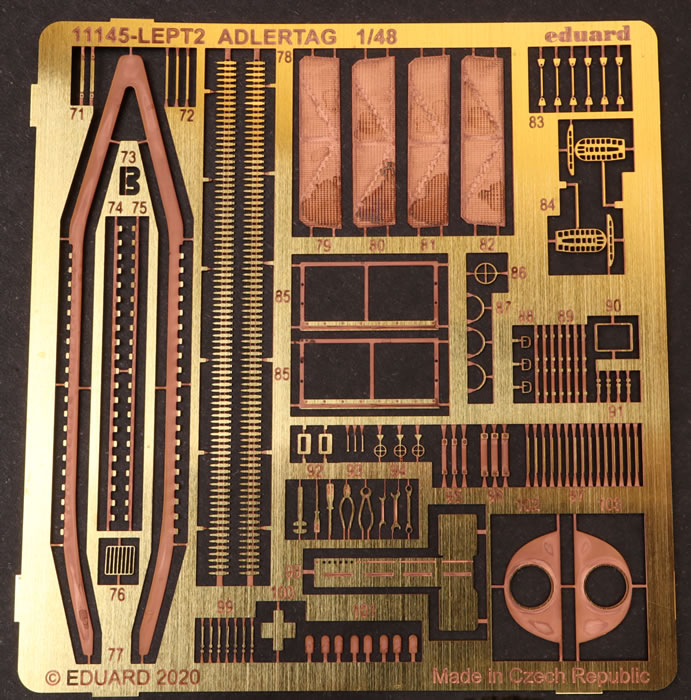
Another interesting bonus item is an MK 101 30mm cannon used in Bf 110C-6. This is supplied via six perfectly cast Eduard BRASSIN resin parts.
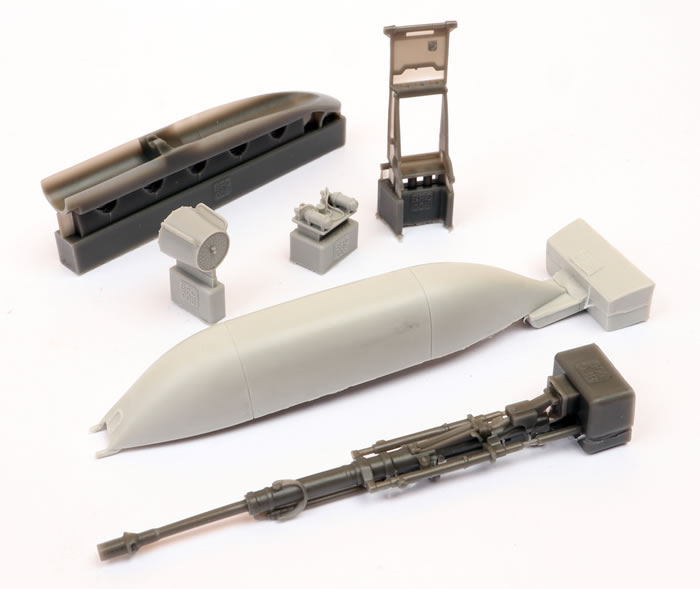
Six pilots and ground crew figures plus ordnance and accessories are also included.
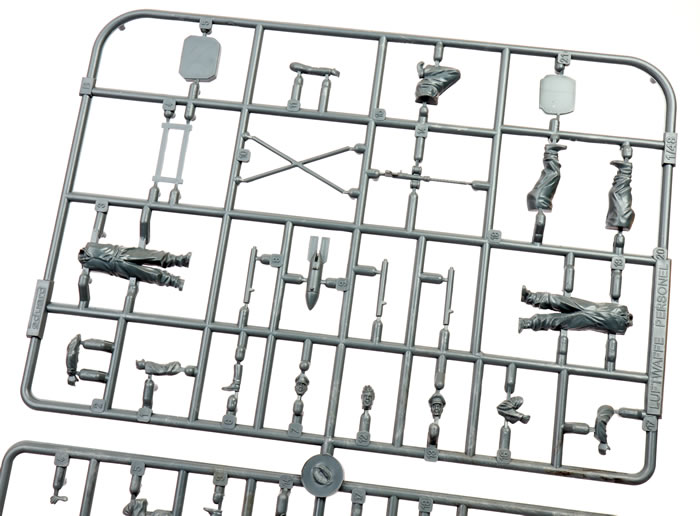
These have previously been available as a standalone release from Eduard.
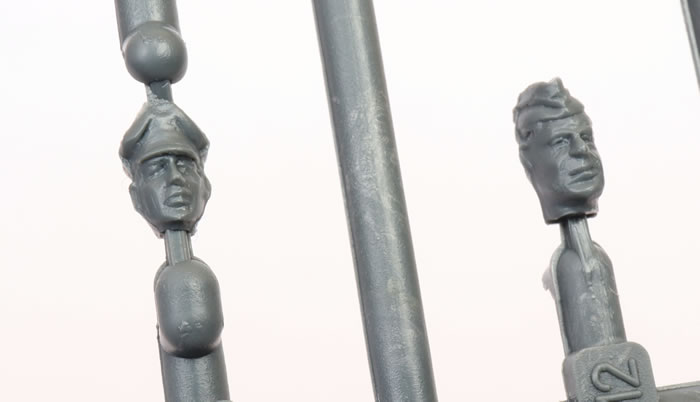
The Kits - The Details...
The plastic parts for the kit are contained on seven sprues via fine connectors.
Moulding quality was superb upon the kit's original release in 2007 and it is just as nice today. I could not find a single sink mark or
ejector pin in any area that will be visible on the finished model.
Crisply recessed panel lines are partnered with incredibly subtle rows
of rivets. I like the treatment of the fabric control surfaces too, with
rib tape detail being the most prominent feature - no massive sagging of
fabric.
The fuselage is broken down into the main halves with a separate nose
(upper and lower) plus an insert for the deck immediately aft of the
cockpit. As mentioned earlier, oe standard fuselage is supplied along with a separate longer fuselage with the "boat tail" moulded in place.
The cockpit is comprehensively fitted out with a combination of delicate
plastic and colour photo etched parts.
The lower fuselage cannon are
visible through the fuselage floor, and plenty of spare ammunition is
provided. The rear gunner's seat can be made to swivel, while the
navigator's seat may be posed up or stowed.
The nose is fully equipped with four MG 17 machine guns and
ammunition feeds plus oxygen bottles. These may be displayed by posing
the separate gun cowl open.
The wings are moulded with the flaps and leading edge
slats in the closed position. This may disappoint some modellers, but I
did a quick check of several books and nearly half of the Bf 110s were
parked with the slats and flaps up. If you really want to drop the flaps
and/or slats, the kit engineering will make this task fairly
straightforward with the bulges behind the nacelles moulded as part of
the bottom of the kit flaps.
Ailerons are provided as separate parts.
Wheel well detail is excellent
The shape of the spinners looks good, and the prominent pitch collars
are moulded near the base of each propeller blade. These should be
clearly visible when the propeller assembly is complete. The main wheels
seem to best represent those of the Bf 110 E -
reference photos suggest that the hubs should be smaller for the Bf 110
C and D.
Two sprues of clear parts are included for the kit. The prominent
glasshouse is an important part of the Bf 110's character, and Eduard
has done an especially good job on the complex rear clamshell. If the
rear canopy is to be depicted open, separate parts are supplied for the
clamshell and the sliding top rear sections. If the canopy will be
closed, a totally separate single part is used. A separate piece of
armoured glass is also depicted, with an alternate photo-etched frame if
the modeller prefers. The side and top canopy parts are also individual
pieces to permit posing in the open position. Furthermore, alternate
styles of rear canopy are offered - with the machine gun cutout and
without. Handles and other canopy details are supplied in both photo
etch and plastic. Eduard masks are also included to ease the pain of
painting that maze of canopy frames.
The original kit suffered from a few steps and gaps around the engine nacelles but Eduard addressed these issues wtih re-designed parts in this area. Fit of the engine nacelles should benefit from the revised parts in this kit.
Marking Options
Two large decals sheets cover 12 varied options covering the Blitzkreig to Battle of Britain eras.
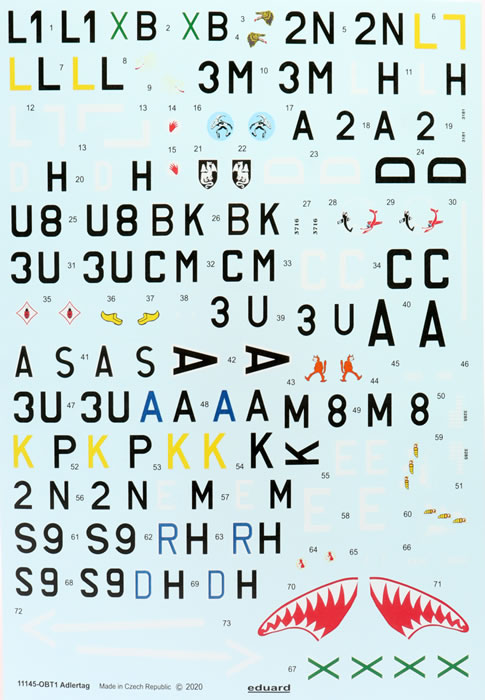
Decals look well printed on my sample and are in perfect register
and colour saturation.

These appear to be Eduard's latest style of decal that theoretically allow the modeller to lift off the carrier film after the decals have set, although my results with this tecthnique using spare decals and painted scrap models have been inconsistent.

The decals still look fine even without the carrier film removed.
Having built the original Bf 110 E kit upon its release, I can advise that it
looks as good when it is finished as it does in the box!
The high parts
count and some of the smaller and delicate parts mean that previous
modelling experience will be helpful before tackling this project.
This remains a highly detailed and accurate kit.
Thanks to Eduard for the sample
Review Text Copyright © 2021 by
Brett Green
Page Created 24 March, 2021
Last updated 24 March, 2021
Back to HyperScale Main Page
Back to Reviews Page |
